Worried about your LVP flooring warping? Don’t let temperature changes ruin your beautiful investment. I’ve seen firsthand how crucial proper installation is for LVP stability.
Ensuring LVP stability means understanding its natural expansion and contraction. Proper installation, including essential expansion gaps, manages this movement. This keeps your floors looking great and prevents issues like buckling or gapping over time, giving you peace of mind.
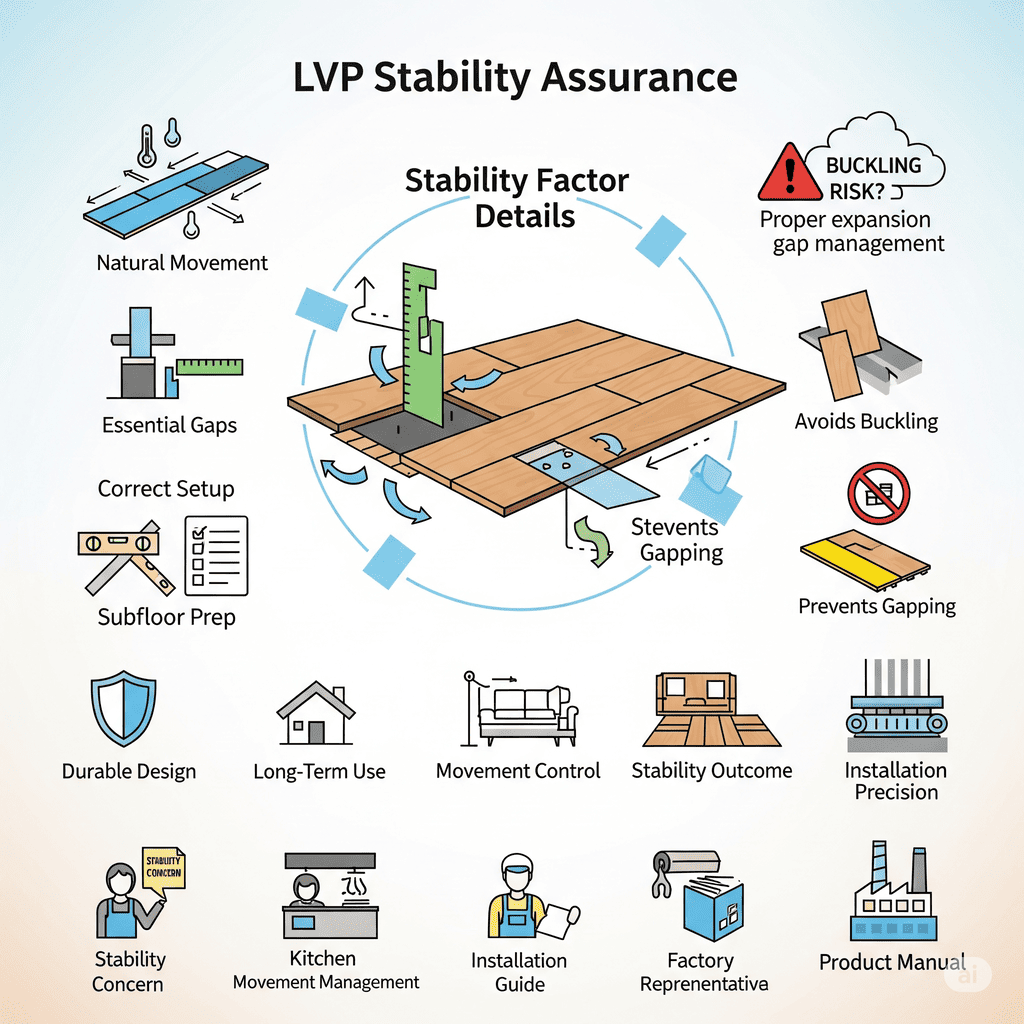
Understanding LVP’s movement is key. It helps you avoid big problems later. Let me explain how to get it right from the start.
How much does Luxury Vinyl Plank typically expand and contract, and why are expansion gaps essential for installation?
Is LVP really that flexible? Yes, it moves more than you think. Ignoring this can lead to major floor damage1. I’ll show you why this matters.
LVP typically expands and contracts subtly with temperature changes, often around 1/8 inch per 10 feet. Expansion gaps are essential because they provide space for this movement, preventing buckling, lifting, and gapping, ensuring your floor’s longevity.
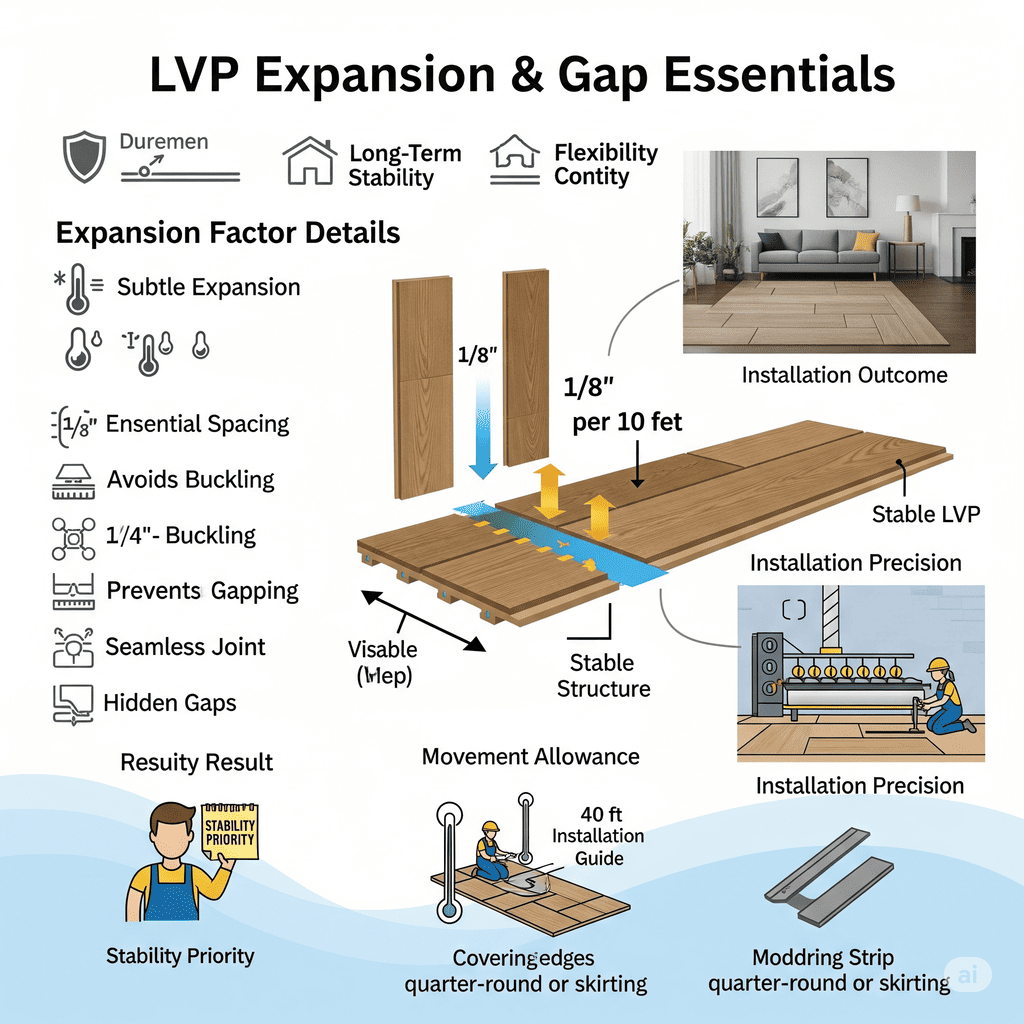
From my experience working with large-scale buyers like Aiden in the UK, understanding material behavior is a top priority. Luxury Vinyl Plank (LVP) flooring, made from PVC compounds, will naturally expand and contract slightly. This happens because of changes in temperature and humidity.
Research shows that each plank can move by about 1/8 inch for every 10 feet of its length. This movement varies depending on the specific product and environmental conditions. For example, in a room that is 40 feet long, the total expansion of the LVP could be as much as 1/2 inch. This is why proper installation is so important.
Expansion gaps are the deliberate spaces we leave around the edges of a room. We also leave them around fixed objects, like walls, door frames, or radiator pipes. These gaps are designed to give the LVP room to move freely without being constrained.
For most LVP installations, we recommend a minimum gap of 1/4 inch (6.35mm). Some manufacturers might specify gaps from 4mm to 8mm. If these gaps are not present, the flooring will experience stress. This stress can cause problems like buckling or warping.
To keep the floor looking good, we can hide these gaps with quarter-round molding, transition strips, or skirting boards. Without these essential gaps, your floor could get damaged or have unsightly issues.
| Room Size (Length) | Typical Movement (per 10 ft) | Recommended Expansion Gap | Potential Issue Without Gap |
|---|---|---|---|
| Up to 20 feet | ~1/4 inch | 1/4 inch (6.35 mm) | Minor buckling/gapping |
| 20-40 feet | ~1/2 inch | 3/8 inch (9 mm) | Significant buckling |
| Over 40 feet | >1/2 inch | 1/2 inch (12 mm) | Severe floor distortion |
This small allowance prevents future headaches and keeps your LVP installation looking perfect for years.
What key factors, such as core type and temperature, influence the degree of Luxury Vinyl Plank expansion and contraction?
Are all LVP types equally stable? Not exactly. Some factors make a big difference in how much your flooring moves. Ignoring these details can lead to unexpected issues.
The core type of LVP, like SPC (Stone Plastic Composite) or WPC (Wood Plastic Composite), significantly influences its stability. SPC, with its rigid stone-polymer core, is far more stable than WPC or traditional LVT, which have less dense cores. Temperature and humidity also play a huge role; wider swings cause greater movement.
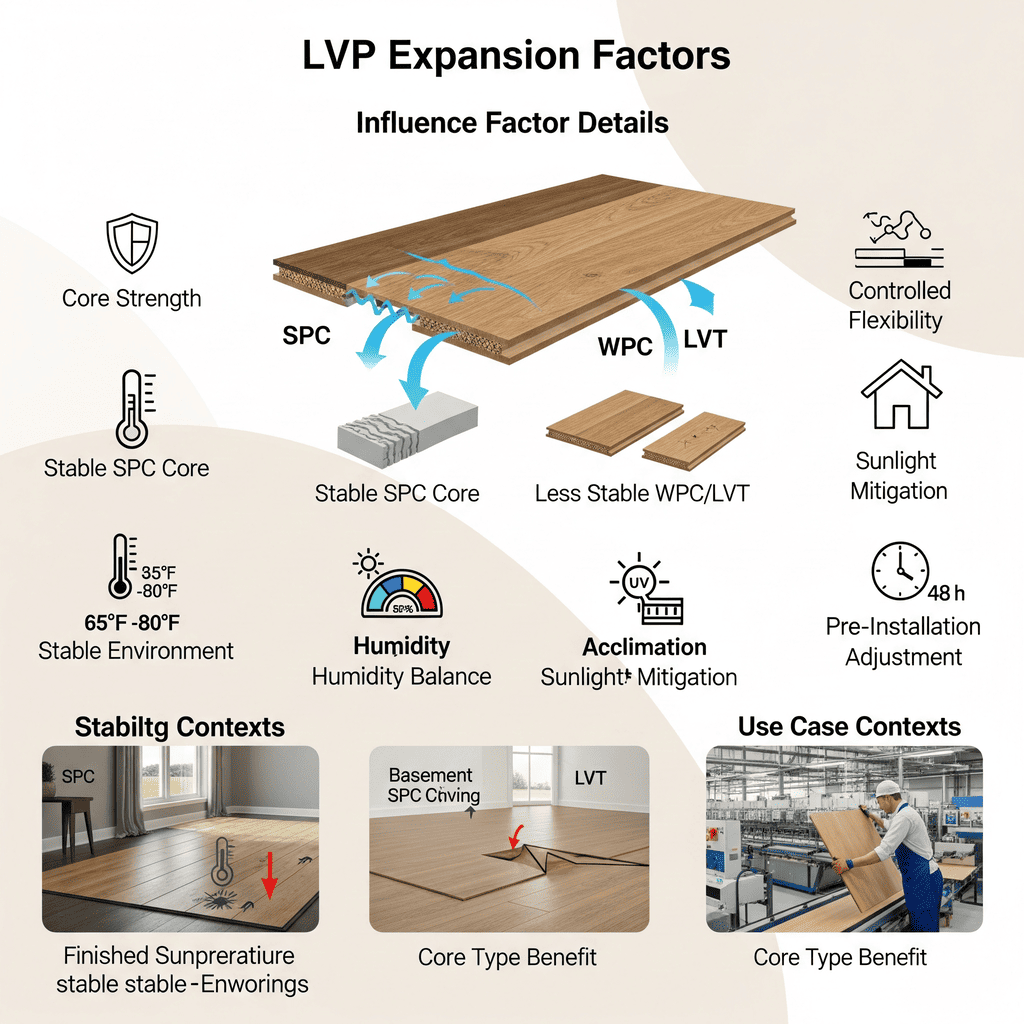
When Louis, our client from the US, discusses SPC flooring, stability is always a key topic. She knows quality matters. The core of an LVP plank is like its backbone. It determines how much the plank will expand or contract.
For example, SPC (Stone Plastic Composite) flooring has a very dense and rigid core. This core contains powdered limestone, which makes it incredibly stable. It resists changes from heat much better than WPC (Wood Plastic Composite) or traditional LVT (Luxury Vinyl Tile) planks.
WPC has a wood plastic composite core, which is lighter and softer. It feels warmer underfoot but moves more with temperature1 changes. Traditional LVT, often with a flexible PVC core, is the most prone to movement. This is why we often recommend SPC for areas with wide temperature swings, like sunrooms or basements. I have seen projects where the wrong core type2 was chosen, and the flooring buckled in extreme heat.
Temperature is a major factor. Vinyl is very sensitive to temperature changes.
- High temperatures, usually above 80°F (27°C), cause the LVP to expand.
- Low temperatures, below 65°F (18°C), make it contract.
- Maintaining a consistent indoor temperature between 65°F and 80°F (18-27°C) helps a lot to minimize movement.
- If you have radiant heating systems, make sure they don’t go over 85°F (29°C).
Humidity also plays a big role.
- High humidity3 levels, above 55%, can make LVP expand.
- Low humidity, below 35%, can lead to contraction.
- The ideal humidity range for LVP stability is between 35% and 55%.
Direct sunlight is another concern. Long exposure to direct sunlight can heat the floor a lot, causing localized expansion. This is why using window coverings or UV film on windows helps reduce this risk. Proper acclimation of LVP before installation, typically for 48 hours in the installation environment, is also critical. It lets the material adjust to the room’s conditions, reducing unexpected movement.
| Factor | Impact on LVP Movement | Ideal Conditions for Stability |
|---|---|---|
| Temperature | Expands in heat, contracts in cold | 65°F–80°F (18°C–27°C) |
| Humidity | Expands in high, contracts in low | 35%–55% Relative Humidity |
| Core Type | SPC more stable than WPC | SPC (Stone Plastic Composite) |
| Direct Sunlight | Causes localized expansion | Use window coverings/UV film |
| Acclimation | Reduces unexpected movement | 48 hours in room before installation |
These factors, combined with proper installation, ensure the long-term stability of your LVP.
How do different subfloor types, like wood versus concrete, impact the expansion and contraction behavior of Luxury Vinyl Plank?
Does your subfloor affect your LVP? Absolutely. The base beneath your LVP plays a vital role. Getting this wrong can lead to serious floor problems.
Different subfloor types, such as wood and concrete, impact LVP movement. Concrete subfloors are generally more stable but need moisture testing and vapor barriers. Wood subfloors, however, can expand and contract with humidity, potentially transferring some instability to the LVP if not properly prepared and leveled.
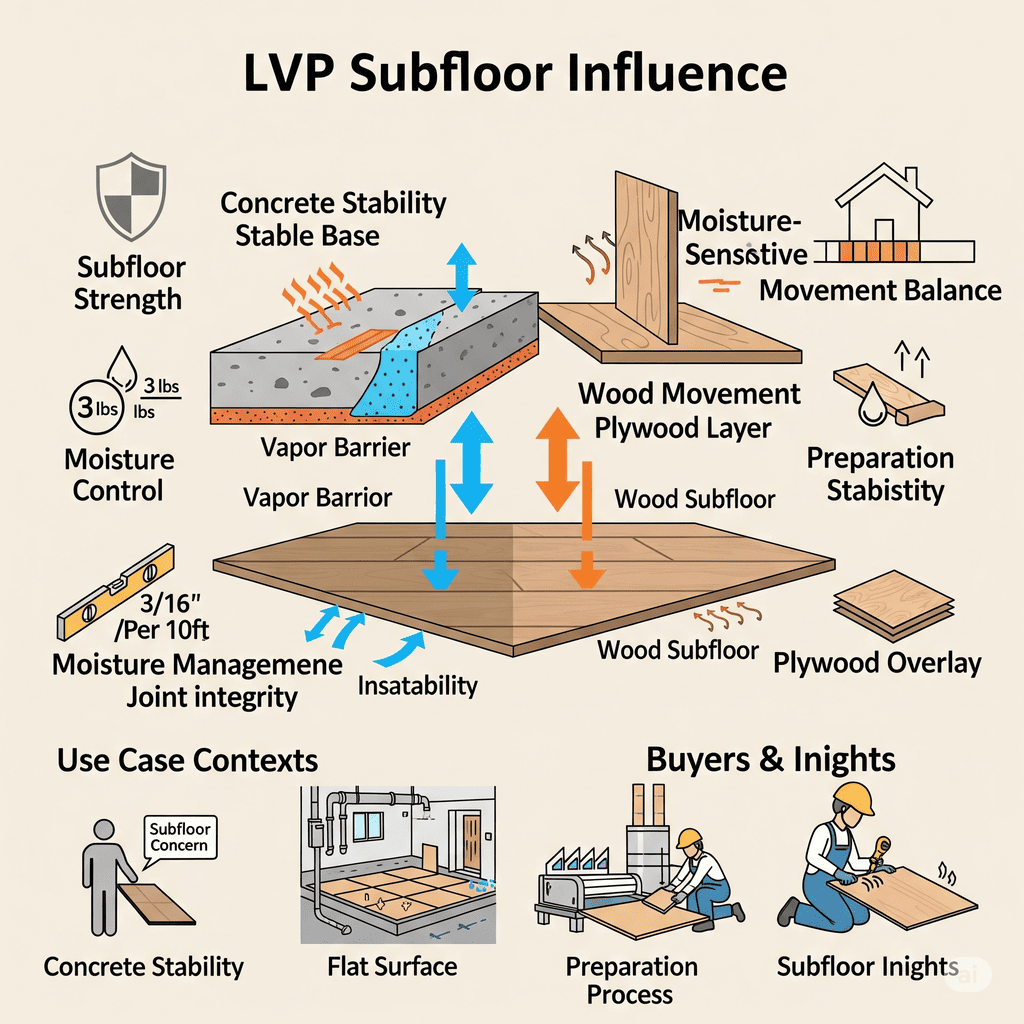
When we ship LVT and SPC flooring to our clients in North America and the Middle East, we always stress the importance of subfloor preparation1. A subfloor is the foundation your LVP sits on, and its behavior affects the LVP’s movement.
Wood subfloors, like plywood or oriented strand board (OSB), are hygroscopic. This means they can absorb or release moisture. This causes them to expand or contract themselves. This movement can then affect the LVP installed on top, especially if the subfloor isn’t prepared correctly.
To ensure stability, wood subfloors should be covered with a 1/4-inch plywood layer. The joints of this plywood should be offset. We also recommend leaving a 1/4-inch expansion gap around walls. The subfloor must be clean, dry, and level within 3/16 inch per 10 feet. If the wood subfloor is damaged or has too much moisture, it can cause problems like buckling or cracking in your LVP.
Concrete subfloors are generally more stable than wood. However, they can hold a lot of moisture, especially if they are newly poured or not sealed properly. High moisture levels, usually above 3 lbs per 1,000 square feet over 24 hours, can affect LVP. This might cause expansion or even make the adhesive fail in glue-down installations.
For floating LVP installations over concrete, we often need a vapor barrier to prevent moisture-related issues. The concrete itself must be cured for at least 60 days. It also needs to be leveled to ensure a smooth surface. Proper moisture testing2 and sealing are very important to keep LVP stable.
While the subfloor type itself doesn’t directly change how much the LVP expands, its condition—especially its moisture content and how level it is—plays a big part in how the flooring performs. Both wood and concrete subfloors need careful preparation to avoid problems.
| Subfloor Type | Key Characteristic | Preparation Required | Impact on LVP Stability |
|---|---|---|---|
| Wood | Absorbs/releases moisture, moves | 1/4" plywood layer, offset joints, level, dry | Good, if proper acclimation |
| Concrete | Stable, can retain moisture | Moisture test (max 3 lbs), vapor barrier, level | Very good, if dry and level |
Ensuring your subfloor is perfectly flat is also crucial. Any dips or humps can cause stress on the LVP, leading to gapping or breakage at the click joints over time.
Are there specific considerations for managing Luxury Vinyl Plank expansion and contraction when installing in very large rooms?
Do big rooms pose bigger LVP problems? Yes, the larger the space, the more care you need. Ignoring room size can lead to noticeable floor damage.
Yes, very large rooms require specific considerations for LVP expansion and contraction. For installations exceeding typical room dimensions (often 50 feet in any direction), manufacturers recommend using wider gaps or control joints. These create intentional breaks within the floor, dividing the large area into smaller, more manageable sections to allow for proper movement and prevent buckling.
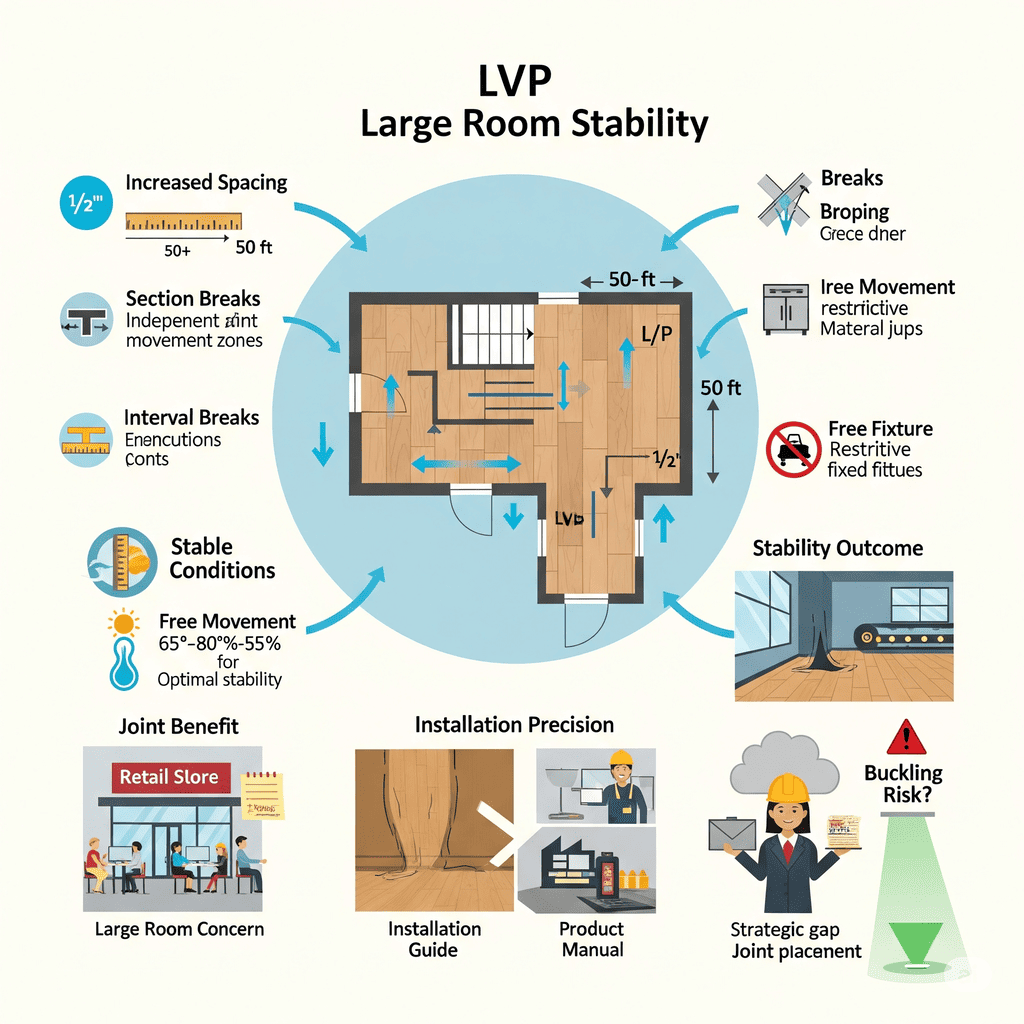
For large commercial projects, especially those our distributors undertake in the UK, managing LVP movement in expansive open spaces is a critical design point. Imagine a large retail store or an open-plan office. A single continuous run of LVP across a very long distance, say over 50 feet, will experience significantly more total expansion and contraction than a shorter run. This increased movement builds up stress.
If this stress is not released, the LVP can buckle severely. It will often lift off the subfloor in waves. To prevent this, professional installers use what are called "expansion breaks1" or "transition moldings." These are typically T-shaped moldings that are installed across the floor at specific intervals.
They create a deliberate gap, similar to an expansion gap around the perimeter, but within the floor itself. This effectively breaks the large floor into smaller, independent sections. Each section can then expand and contract without putting pressure on the adjacent section.
- For rooms under 50 feet in length or width, a 1/4-inch (6.35mm) expansion gap is typically sufficient.
- However, for rooms exceeding 50 feet, manufacturers may recommend increasing the gap to 1/2 inch to accommodate greater movement. This ensures the floor can expand without buckling.
- In extremely large installations, such as commercial spaces, control joints2 may be used to divide the floor into smaller sections. Each section has its own expansion gap, allowing independent movement and reducing stress across the entire floor.
Installers should calculate the potential total expansion based on the room’s dimensions and the LVP’s expansion rate (e.g., 1/8 inch per 10 feet). For a 60-foot room, the total expansion could be up to 3/4 inch, necessitating careful planning. Maintaining consistent temperature (65°F–80°F) and humidity (35%–55%) is critical in large rooms, where gradients in conditions can be more pronounced. Window coverings should be used to minimize direct sunlight exposure. Floating floors, common for LVP, must not be glued or nailed to the subfloor. Heavy fixtures like cabinets should not be installed on top, as this restricts movement and increases the risk of buckling.
| Room Dimension Category | Recommended Strategy | Typical Break Interval | Result if Ignored |
|---|---|---|---|
| Standard (up to 50 ft) | Perimeter expansion gaps only | N/A | Minor gapping |
| Very Large (>50 ft) | Wider gaps or control joints | Every 40-50 feet or as specified | Moderate to severe buckling |
The exact spacing for these breaks depends on the LVP product and manufacturer guidelines. We at CloudsFlooring always advise our clients to consult the manufacturer’s installation instructions for specific limits on continuous runs. This attention to detail ensures the integrity and beauty of the floor in large-scale applications.
What are the potential consequences if Luxury Vinyl Plank is installed without adequate allowance for movement?
Will my LVP be okay without expansion gaps1? No, absolutely not. Skipping these crucial gaps can lead to costly and ugly damage. You don’t want to find out the hard way.
If LVP is installed without adequate allowance for movement, the consequences can be severe. The most common issues include buckling, cupping, or tenting of the planks as they expand and have nowhere to go. This can also lead to gapping, where planks pull apart when they contract, creating unsightly gaps and compromising the floor’s integrity and appearance, requiring costly repairs or full replacement.

I’ve unfortunately seen the results of installations where corners were cut on expansion gaps. For a large company buyer like Aiden, who focuses on quality, these issues are deal-breakers.
When LVP planks expand due to heat and have no space, they push against anything solid – walls, door frames, or even other planks. This pressure builds up, causing the planks to rise in the middle, creating humps. This is known as "buckling2" or "tenting." It looks terrible, creates trip hazards, and can even crack the planks.
On the other hand, if the planks are installed too tightly and then contract in cooler temperatures, they can pull away from each other. This leaves visible gaps between the planks, which collect dirt and moisture and make the floor look cheap and poorly installed. I had a client once who faced significant chargebacks due to gapping issues because his installer skipped this step.
These consequences highlight why proper installation is so important.
- When planks expand without sufficient space, they push against walls or other planks, causing the floor to buckle or form peaks. This creates an uneven surface and can damage the flooring.
- Restricted expansion can also cause planks to warp or deform. This compromises their appearance and structural integrity.
- During contraction, if the planks are not installed properly, they can pull apart, leaving visible gaps between them.
- In severe cases, expanding planks can even exert enough pressure to damage walls, baseboards, or the subfloor, leading to very costly repairs.
It is important to know that many manufacturers require specific expansion gaps as part of their installation guidelines. If you fail to follow these guidelines, it can void the warranty. This leaves owners responsible for all repair costs.
These problems are not just cosmetic; they affect how long your floor lasts and how well it performs. Fixing them often means removing parts of the floor, which takes time and money. Sometimes, you might even need to replace the entire floor. For B2B clients sourcing from us at CloudsFlooring, avoiding these problems is paramount for their reputation and profit margins. We ensure our products meet quality standards, but proper installation, including vital expansion gaps, is equally important to prevent these preventable failures.
Common Problems from Insufficient Gaps:
- Buckling/Tenting1: This happens when planks expand and have no room. The floor lifts and forms ridges, often in the middle of a room. It looks like a tent.
- Warping: Restricted expansion can cause planks to warp or deform. This compromises their appearance.
- Gapping: When planks contract and pull apart, especially near seams or ends. This creates unsightly gaps.
- Structural Damage2: Extreme pressure from expanding planks can damage walls or baseboards, leading to costly repairs.
- Voided Warranty3: Failure to follow manufacturer guidelines regarding expansion gaps can void your warranty, making you responsible for all repairs.
These issues are not just cosmetic. They compromise the flooring’s performance and lifespan. Repairing them often means removing sections of the floor, which is time-consuming and expensive. Sometimes, the entire floor needs to be replaced. For B2B clients sourcing from us at CloudsFlooring, avoiding these problems is paramount for their reputation and profit margins. We ensure our products meet quality standards, but proper installation, including vital expansion gaps, is equally important to prevent these preventable failures.
Conclusion
Managing LVP movement is essential for lasting floors. Proper expansion gaps, considering core type, temperature, subfloor, and room size, prevent buckling and gapping. Following these steps ensures your LVP stays stable and beautiful.
The above data is for reference only.
-
Understanding the causes of buckling can help you prevent this issue in your flooring projects, ensuring longevity and quality. ↩ ↩ ↩ ↩ ↩ ↩
-
Identifying structural damage early can save you from costly repairs and ensure the integrity of your flooring. ↩ ↩ ↩ ↩ ↩
-
Learn how a voided warranty can impact your flooring investment and the importance of following installation guidelines. ↩ ↩
